

Jon Clements, Author (unless otherwise noted) and Editor
Current degree day accumulations
New England Tree Fruit Management Guide on-line
| UMass Cold Spring Orchard, Belchertown, MA |
24-April |
| Base 43 (BE, NEWA) | 335 |
| Base 50 (BE, NEWA) | 162 |
Note that apple king bloom should occur app. 190 DD (Base 50 BE), although obviously there is a range. We are currently at 162 DD's Base 50 BE in Belchertown. Based on the degree-day forecast, we will be at king bloom in Belchertown on app. Friday-Saturday, 28, 29-April.
Current bud stages. April 24, 2017, UMass Cold Spring Orchard, Belchertown, MA
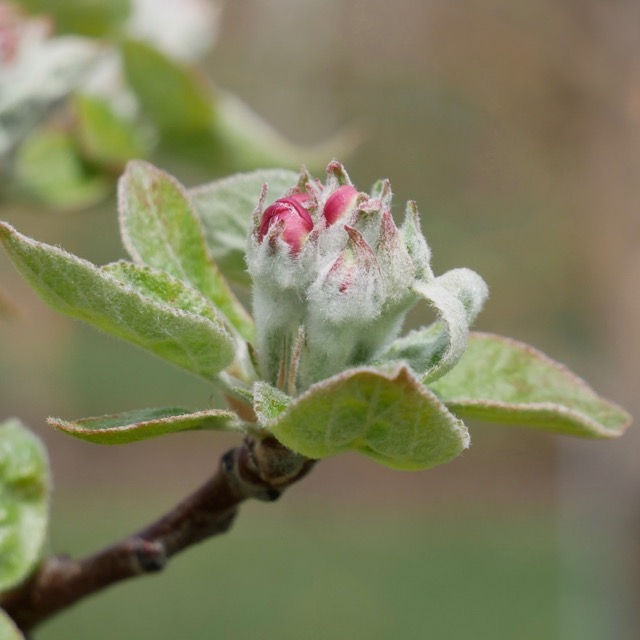 |
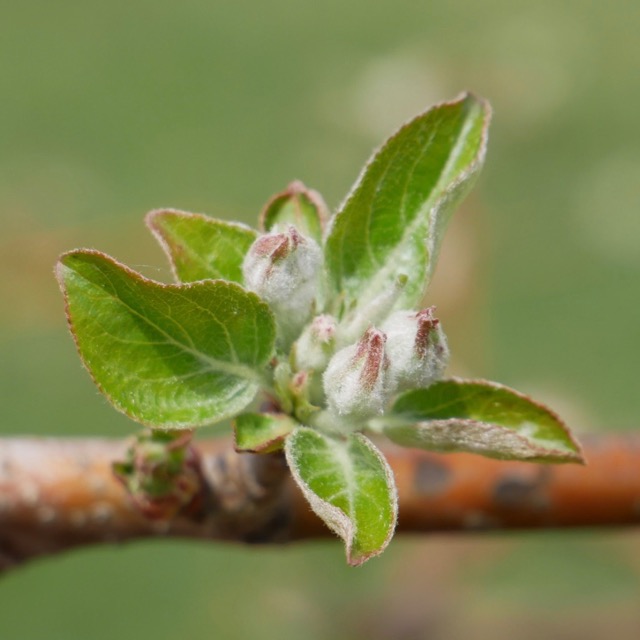 |
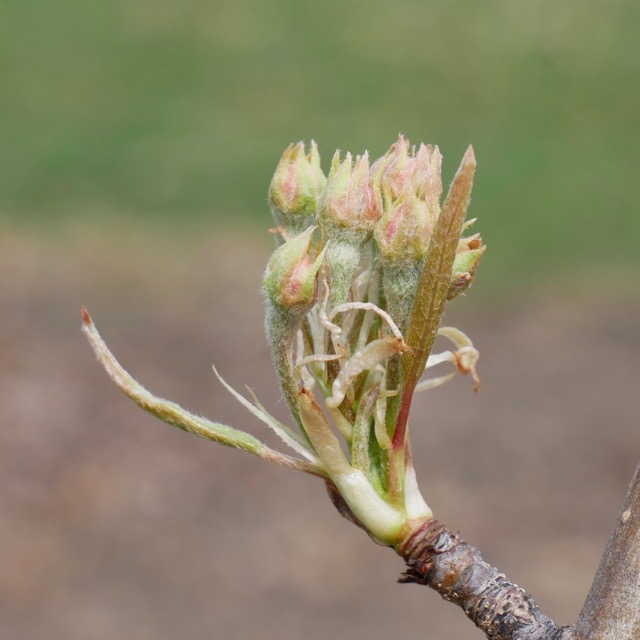 |
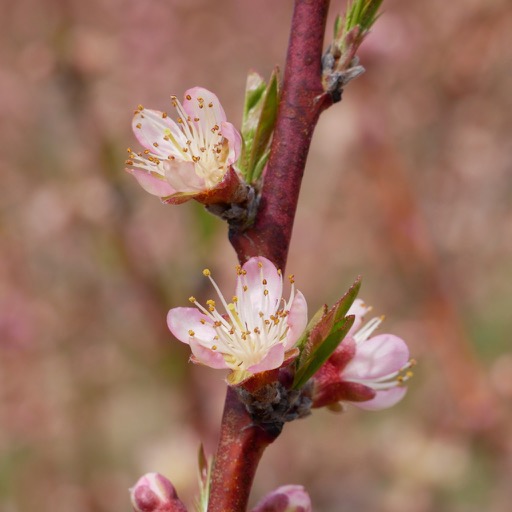 |
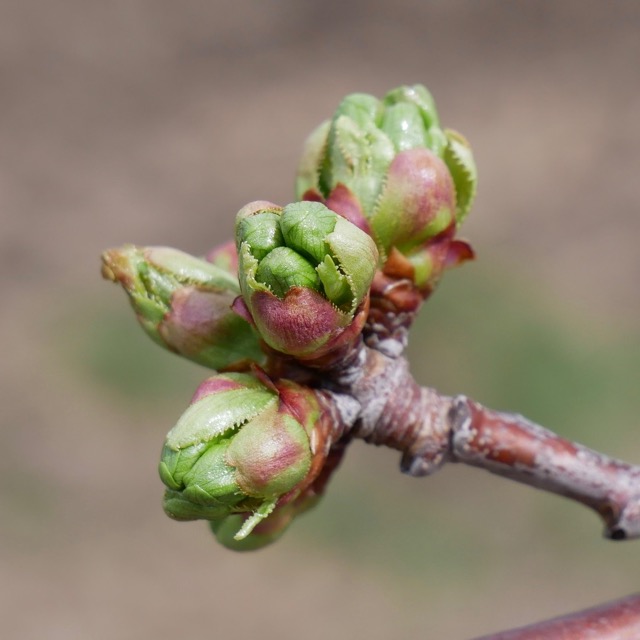 |
McIntosh apple very early pink |
Honeycrisp apple tight cluster |
Gold bosc pear green cluster |
Redhaven peach early bloom |
Regina sweet cherry bud burst |
| Coming events | Degree days (Base 43 BE) |
| Codling moth 1st catch | 392-521 |
| European red mite egg hatch complete | 368-470 |
| Green fruitworm flight subsides | 267-465 |
| Lesser appleworm 1st catch | 276-564 |
| Lesser appleworm 1st flight peak | 364-775 |
| Oriental fruit moth 1st flight peak | 329-534 |
| Spotted tentiform leafminer 1st flight peak | 268-407 |
| Spotted tentiform leafminer sapfeeding mines present | 343-601 |
| McIntosh bloom | 344-416 |
Key insect life cycle and management dates
Note: for 2017, we have four Massachusetts orchard locations subscribed to AR: Amherst, Belchertown, Deerfield, and Easthampton. The website for looking at AgRadar for these locations is: http://extension.umaine.edu/ipm/ag-radar-apple-sites/. What follows is the AgRadar summary for the Belchertown location.
Estimated apple Scab Ascopsore Maturity, 25-April -- 22%
Lesser Appleworm LAW -- 1st LAW flight begins around: May 4, Thurssday. Peak trap catch: May 16.
Oriental Fruit Moth OFM -- 1st generation OFM flight starts: April 26, Wednesday. 1st generation 55% egg hatch and first treatment date, if needed: May 25, Thursday.
Redbanded Leafroller RBLR -- Peak trap catch and approximate start of egg hatch: April 28, Friday
Spotted Tentiform Leafminer STLM -- 1st STLM flight, peak trap catch: May 4, Thursday.
McIntosh Bud Stages -- Tuesday, April 27: full Pink-extended; Friday, April 28: late Pink; Sunday, April 30: King Bloom; Monday, May 1: Full Bloom; Monday, May 8: 95% Petal Fall; Wednesday, May 10: 100% Petal Fall
25-April, 2017 (Tuesday) Fruit Twilight Meeting at 5:30 PM. Outlook Farm 136 Main Road, Westhampton, MA. Brad Morse will be our host. 1 pesticide credit will be offered. Light dinner will be served. $20 admission. Contact: Jon Clements, 413-478-7219. Pre-registration is not necessary.
3-May, 2017 (Wednesday) Airblast Sprayer Calibration Demonstration at 3 PM. (Re-scheduled from 25-April.) Outlook Farm 136 Main Road, Westhampton, MA. Co-sponsored by UMass Extension Integrated Crop Management Program (eIP). 1 pesticide credit will be offered. $20 admission. Contact: Jon Clements, 413-478-7219. Pre-registration is not necessary.
For more information and updates, see Upcoming Events
Jon Clements
• In reality, everyone has presumably covered-up with a fungicide for apple scab, and based on the weather forecast, we will be in bloom within the week, so it's probably too late to do much except maintain fungicide coverage for scab and where stone fruit is in bloom, yes, fungicide for blossom brown rot (options here). Don't forget to include a mildew control fungicide somewhere along the way in your scab control program before and after bloom.
• There has been a lot of chatter about pre-bloom (aka tight cluster to pink) insecticides for tarnished plant bug, European apple sawfly, rosy apple aphid, etc. Options include Lorsban (heavy hitter organo-phosphate, ugh, and then can't use as a trunk spray for dogwood borer later), pyrethroids (hard on predators, very good on plant bug), Imidan (European apple sawfly mostly), neo-nics (Actara, Assail, bee issues?), and ta-da, Exirel, which is a relatively new insecticide from DuPont and appears to have a pretty good fit for a pre-bloom insecticide. Your call, but overall pre-bloom insecticide probably not warranted unless you want 100% clean fruit or you have a history of any one of the above problem insects.
• All pink spray options for diseases and insects can be found here: http://ag.umass.edu/fruit/new-england-tree-fruit-management-guide/apples/spray-table/5-pink
• I suspect fire blight will be an issue beginning this weekend with open bloom, warm temperatures, and wetting predicted, Got Strep?
• Apogee or Kudos, to be most effective should be applied at low-moderate rates beginning at first petal fall. Recommendations for using Apogee/Kudos can be found here: http://ag.umass.edu/fruit/fact-sheets/apogeer-new-growth-retardant-for-apples
• The New England Extension tree fruit specialists -- which include myself and Dan Cooley at UMass. Mary Concklin at UConn, Heather Faurbert at URI, Terry Bradshaw at UVM, George Hamilton and Alan Eaton at UNH, and Glen Koehler and Renae Moran at UMaine -- have started to contribute to an on-line edition of the New England Tree Fruit Management Guide. Call it a beta version if you will, but we think it has some value in 2017 as we continue to work on it. (Consider it dynamic? Work-in-progress? Under construction?) But many of the spray tables (for lack of a better description) are filled out. Note that is it easy to print any of the sections, if you want to have old-school reference, for examplle, to hang on your spray shed wall. Also, it is quite mobile-friendly so make a home screen shortcut to here: http://netreefruit.org.
Jon Clements
I kind of layed it out above, but a really good blog post by Peter Jentsch on insect control options can be found here: http://blogs.cornell.edu/jentsch/2017/04/24/rational-for-insect-pest-management-at-the-pink-stage/
We caught Oriental fruit moth (OFM) in a pheromone trap in Belchertown yesterday (below on right), which sets the biofix for upcoming insecticide control. In general, petal fall sprays of Imidan for plum curculio take care of OFM in both apple and peach, however, using mating disruption too is a good integrated management approach and also needs to be used where insecticide resistance is suspected. Mating disruption ties need to be deployed ASAP, peak flight is predicted to be soon. I noted lots of terminal shoot flagging in peaches late last summer (pictured below on left), so I suspect we have a healthy population of OFM this spring.
.jpg)
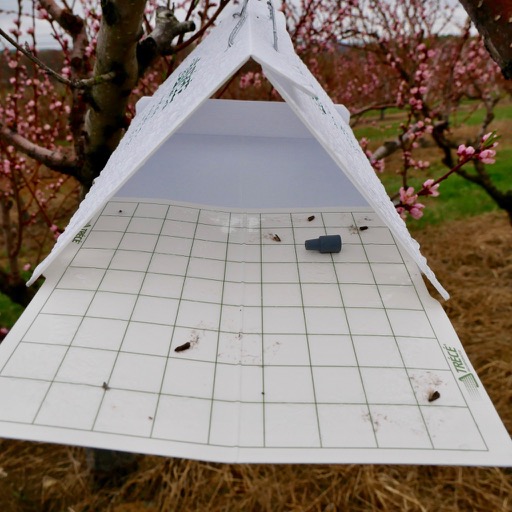
Dan Cooley
There are a number of materials being promoted for as part of a fire blight management program. These so-called biointensive compounds for disease management all stimulate plant disease resistance, so called Systemic Acquired Resistance or SAR. They include chemicals such as Actigard and Serenade, which have been sold for several years, Double Nickel which has been available for a few years, and LifeGard, a new SAR material.
It’s important to know that SAR inducers alone do not perform as well as streptomycin alone against fire blight. However, if used in a program that rotates with streptomycin, they can replace one or two streptomycin sprays.
Why bother? One, it will reduce the chance of resistance against strep developing in the fire blight pathogen. Two, they stimulate systemic acquired resistance – the whole plant becomes more resistant to fire blight. Not completely resistant, just more resistant. The material won’t be washed off, and even newly emerging flowers will have a higher level of resistance. As a result, the combination of strep and an SAR inducer can, in some cases, improve fire blight control.
Actigard is a chemical (acinbenzolar-S-methyl; Syngenta) that stimulates resistance. It can be used with copper, though the standard cautions about russeting with copper still stands. Serenade, Double Nickel and LifeGard are based on bacteria. They induce SAR, and may in some cases knock out the fire blight bacteria in other ways.
Apogee (or Kudos) offers another option to increase fire blight resistance. Early Apogee/Kudos, at late pink/beginning of bloom, at 9 oz. per 100 gal. dilute spray, reduces shoot growth significantly. (Follow up applications may be necessary.) It should also be good for fire blight control. Apogee’s impact on tissue evidently makes it more resistant to the fire blight bacteria. A second application at the same rate may be needed around petal fall, depending on the desired growth reduction and fire blight pressure.
The bottom line, and this is critical, is to monitor fire blight risk using one of the on-line decision support systems, Ag-Radar, NEWA or RIMpro, and be ready with strep when risk is high. At this point, all the models estimate early bloom to start over the weekend or the beginning of next week in most of the state, but do not estimate fire blight risk to be high in Belchertown. But keep an eye on them, as conditions change daily. And to improve fire blight control, consider adding SAR inducers and/or Apogee to the bloom spray program.
Jon Clements
Critical Spring Temperatures for Tree Fruit Bud Development from Michigan State University Extension, nice to print and put on wall so you can stare at and worry. Note apples are most sensitive to sub-freezing temperatures at petal fall, predicted to be May 10. Below is the 14-day forecast from Meteoblue, note the somewhat downward trend, but things look pretty good right now!
Need better branching on newly planted (1-year old wood) or second leaf (1-or 2-year old trees) apple trees? Your options, briefly, include:
For more information, results, and application details, see these articles from Fruit Notes:
Increasing Branching of Newly Planted Apple Trees
Increasing Branching of Newly Planted Trees in the Orchard, an Update
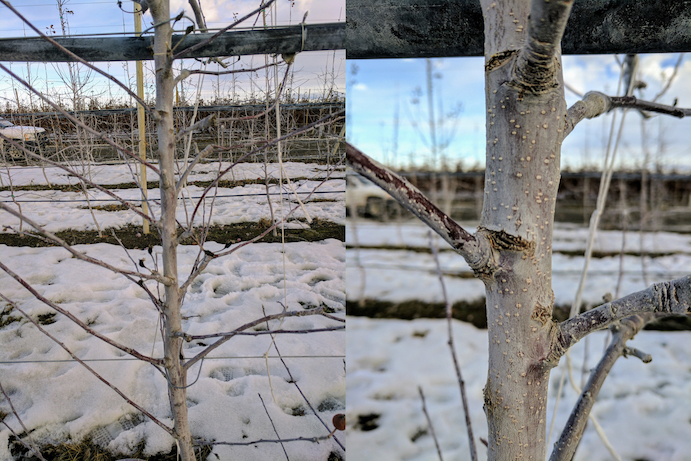
effect of notching with a double-bladed hand pruner the year after notching
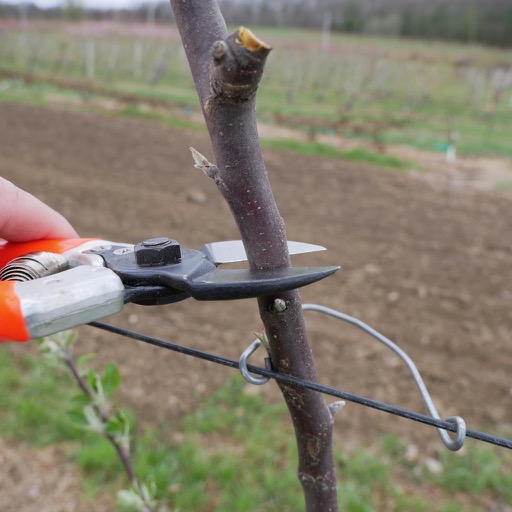
double-cut hand pruner being used to break buds for branching of 2-year old wood

notch just above dormant bud on 2-year old wood made with double-cut hand pruner
No Guest article this week...
Follow me (jmcextman) on FB: https://www.facebook.com/jmcextman
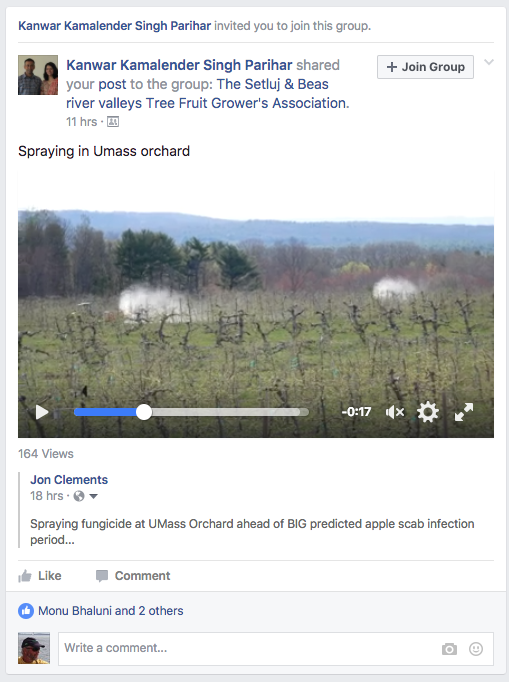
New England Tree Fruit Management Guide
UMass Fruit Advisor: http://umassfruit.com
Scaffolds Fruit Journal: http://www.nysaes.cornell.edu/ent/scafolds/
Network for Environment and Weather Applications (NEWA): http://newa.cornell.edu
Follow me on Twitter (http://twitter.com/jmcextman) and Facebook (http://www.facebook.com/jmcextman)
The next Healthy Fruit will be published on Tuesday, May 2 or thereabouts, 2017. As always feel free to get in touch with any member of the UMass Fruit Team (http://extension.umass.edu/fruitadvisor/team-members) if you have questions or comments.